How to Read Guitar Notes on Guitar Neck
Guitar Fretboard Notes | Complete Tutorial
A Beginner's Guide to Learn the Guitar Neck (+ Guitar Notes Chart Pdf and Notes Training Webapp)
We, guitar players are one of a kind musicians. Often, we never carp to larn the notes of the guitar fretboard , merely we keep relying on fixed chord shapes and scales patterns (don't miss our free chords and scales pdf).
Saxophonists, pianists and other musicians unremarkably exercise their homework and perfectly know where the notes are on the musical instrument. This makes them able to apply music theory , sight-reading , and beingness more complete musicians.
And why we guitarists should we not practice the aforementioned? On this page, you're going to acquire how and why to acquire all fretboard notes . Information technology will be easy and fun, and, higher up all, rewarding .
Suggested Resources For This Tutorial: Free Guitar Fretboard Chart Pdf
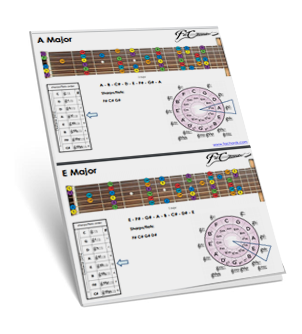
This gratuitous guitar notes map contains several diagrams showing the annotation on the fretboard for each musical fundamental.
This will help you lot sympathize the fretboard stride-by-step , starting from a fretboard map with natural notes only , and introducing one abrupt or flat note at a time.
Download The Fretboard Notes Map Pdf
Interactive Guitar Fretboard
This tool will shows you the notes on the fretboard. Click on a fret or select the name of a notation and the tool will tell y'all the note or the fret position. (like this interactive tools? Cheque the other guitar learning software )
 Loading sounds...
Loading sounds...
Click on a fret above or on a button below
Clear fretboard A B C D East F G A#/Bb C#/Db D#/Eb F#/Gb 1000#/Ab
Guitar Neck Notes | Don't worry, there is a logic in this madness
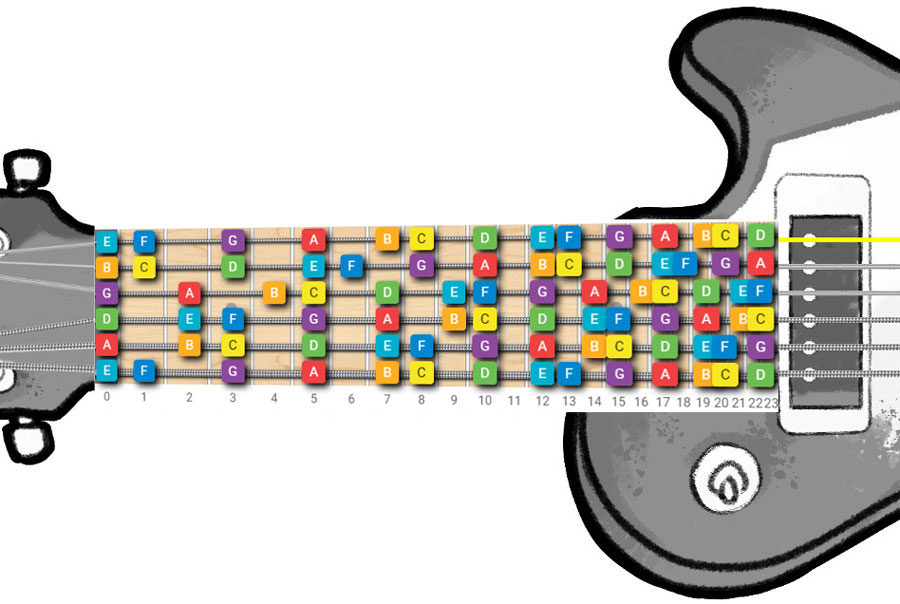
Guitar neck map shown from the aforementioned point of view of the guitar player. Click to zoom
The moving-picture show in a higher place shows you the notes of the fretboard. At first sight, it seems just a big mess: many frets, sharps, flats.
If you need help deciphering this map, for at present merely know that in the diagram the thickest string (Eastward) is at the bottom of the image, and the guitar headstock is on the left .
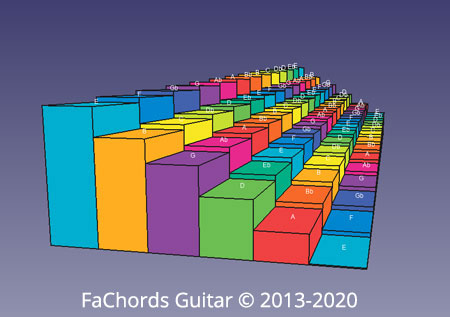 Basically, the diagram is created with the aforementioned indicate of view of a guitar player playing his/her axe. Now we're going to acquire some strategies that simplify all this stuff (if you want something crazy, I fifty-fifty created a LEGO 3d Model of the fretboard, that should assistance you visualize the pitches).
Basically, the diagram is created with the aforementioned indicate of view of a guitar player playing his/her axe. Now we're going to acquire some strategies that simplify all this stuff (if you want something crazy, I fifty-fifty created a LEGO 3d Model of the fretboard, that should assistance you visualize the pitches).
Fretboard Guitar Theory | Outset Things To Know
In that location are some rules that we can exploit in guild to simplify the learning of the fretboard. We'll take this with baby-steps , and then feel you costless to jump to the sections alee if you already familiar.
Some guitar players employ the CAGED arrangement to organize the fretboard. Information technology's an helpful tool, but to fully apply it you need to know the proper noun of the notes, so stick with us and go ahead with this tutorial.
1) Learn the Names of the open strings
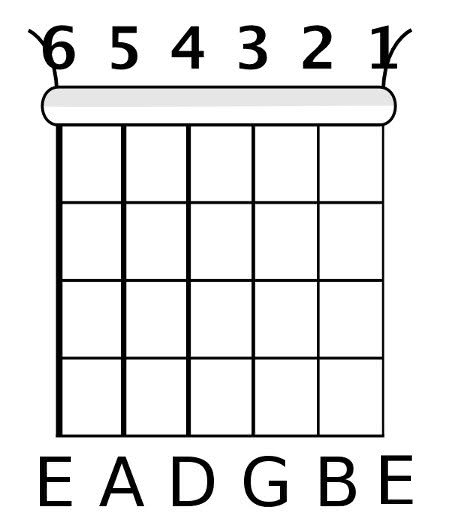 In the first, you should memorize at to the lowest degree 6 notes : the names of the open up strings! You should memorize the name and the order of the strings.
In the first, you should memorize at to the lowest degree 6 notes : the names of the open up strings! You should memorize the name and the order of the strings.
This volition be useful for learning other things. Indeed, often in tutorials and videos, you'll encounter instructions like " identify your finger on the 2d fret of the 6th string ".
So, the names of the open strings are the following :
- 1st string - E (the thinnest, highest pitch)
- 2d string - B
- 3rd cord - M
- 4th string - D
- 5th string - A
- 6th cord - Due east (the thickest, lowest pitch)
For the sake of information abyss, information technology's worth information technology to show you the frequency of the fretboard notes .
Probably in your musical career you'll demand this stuff rarely, simply it's a good matter to know anyway. A pitch is measured in Hertz , each fret has its own pitch.
A well-known frequency is 440 Hertz , that is 2 octaves upwardly the pitch of the A open string, 110 Hertz . The Diapason , also chosen Tuning Fork , a device for tuning the guitar, oscillates at 440 Hertz.
- 1st open up string: East 329.63 Hertz
- 2nd open up string: B 246.94 Hertz
- tertiary open string: 1000 196.00 Hertz
- quaternary open string: D 146.83 Hertz
- fifth open string: A 110.00 Hertz
- 6th open up string: E 82.41 Hertz
We can use a mnemonic trick to assist us memorize open strings names. By using a phrase in which the outset letter of each word corresponds to the name of a string, our life will be easier.
In the examples beneath, the names of the strings are ordered from the thickest to the thinnest ( E A D G B E ):
- E at A ll D ay Chiliad et B ig E asy
- E very A mateur D oes G et B etter E ventually
- E ddie A te D ynamite K ood B ye Due east ddie
- Due east lephants A nd D onkeys G row B ig Due east ars
It'south perfectly fine to create phrases in the opposite society: from the thinnest string (1st) to the thickest (6th), Due east B Thou D A E . Choose what works amend for y'all!
- E aster B unny M ets D runk A fter E aster
- E very B oy Yard ets D izzy A circular E lle
For a more than constructive memorization, y'all should create your own phrases ( in that location are endless possibilities ); hither's one of my phrases, with italian words: East mozionanti A vventure D ove 1000 randi B arche Due east splodono . If you come up up with something cool, please share it in the comments below!
2) The notes of the everyman Eastward string are the same of the highest E string
Probably yous already noticed that actually there are 2 strings with notation E: the everyman (6th) and the highest (1st).
These strings, also called external strings (considering they are at the upper and lower border of the fretboard) have different pitches, but their note names are the same .
So actually nosotros just have to memorize the notes of 5 strings!

The notes on the sixth (thickest) string are the same of the 1st (thinnest) cord! Click to zoom
iii) Learn frets number (0-11)
So far we've considered open strings only. Now it's time to recall horizontally and put our attention on frets. Here are some facts about the frets of the guitar neck:
Frets number 0 corresponds to the open up string
On chord diagrams, tabs and other kind of guitar music notation, if you find a fret numbered with 0 , that means that you should play the string open, without pressing any fret
On each string, the annotation at the fret 0 is the same of the notation at fret 12 (the same for the side by side frets, one=13, 2=14, 3=15 and and then along)
Hither's the reason: in music, in that location are in total 12 notes , the natural notes: C D East F G A B and the precipitous/flats notes (we'll go to this later in this commodity) C#/Db D#/Eb F#/Gb Thou#/Ab A#/Bb
So, if you kickoff from C and become up one note later the other, subsequently 12 steps volition become once more to the C:
C C#/Db D D#/Eb Due east F F#/Gb G One thousand#/Ab A A#/Bb B C
The same happens with guitar frets, if you start from any fret, after 12 steps (or frets) y'all'll get to the same notation.
Let's take equally a case the E lowest string , shown in the picture beneath. The notes of the commencement 11 frets (0-11) are the same of the 12-22 frets:

The notes of the frets from 0 to 11 are the aforementioned of the frets from 12 to 22 (depending on the model, a guitar can have 20-24 frets) Click to zoom
To help yous grasp improve this concept, hither's a unlike angle: a guitar has 2 equal fingerboards of 12 frets each , 1 placed adjacent to the other.
4) Use Fretboard Inlays as a visual help
Even if on certain brands fretboard inlays are fancy and sometimes really cute, they are also useful for finding your way on the neck.
You can exploit them as landmarks for fretboard navigation . On nigh of the guitars, these rules apply:
- An inlay is applied at the third fret
- An inlay is applied at the 5th fret
- An inlay is applied at the 7th fret
- An inlay is practical at the ninth fret
- A double inlay (or other symbol) is applied at the twelfth fret
- The aforementioned pattern is repeated on the frets in a higher place the 12th (inlays on frets 15, 17, 19, 21 and double inlays on 24)
Ok, so far nosotros have learned that actually, we need to learn the notes of just 12 * 5 = 60 frets (because the first 12 frets are the same of the side by side 12, and the 1st and the 6th strings have the same notes).
Merely there are many other things that can assist us master the fretboard .
We're going to take a look in depth at the geometry of the fretboard in the next sections:
Guitar Notes On Staff
Hither below you find six images showing the fretboard notes on staff. Fifty-fifty if the ability of reading music is not strictly mandatory for being a great musician, it certainly helps.

E low string notes on staff

A string notes on staff

D string notes on staff

1000 string notes on staff

B string notes on staff

E high string notes on staff
How To Actually Chief The Fretboard
Now things are going to get interesting. Once Andres Segovia , the famous virtuoso Castilian classical guitarist, said " The guitar is the easiest musical instrument to play, and the hardest to play well ".
Truthful story. Even if you're a complete beginner, y'all could memorize a pair of chord shapes, strum the strings a flake, and you can tell yourself that you're " playing the guitar ".
But you tin't say anything about the notes that compose the chords you're playing, or how to introduce variations in what you're playing. In the following, nosotros'll larn how the fretboard really works.
Before going forwards, be sure to get your free access to the download surface area here: you'll get access to many chords, scales and theory pdfs.
Why Should I learn The Fretboard?
Learning the fretboard opens upwards a new world of possibilities
I make you a promise: if you lot want to actually empathize the guitar fretboard theory, and y'all are set to commit yourself in studying and learning a bit of music theory and its relationship with the cervix geometry , you'll exist rewarded with the ability to play improve and better.
During your solos, y'all'll find automatically the notes that your mind and your eye suggest.
Long story made short, y'all'll play music, not guitar .
If you have ever felt yourself similar trapped in fixed scale patterns and chord shapes, yous know what I hateful.
Ok, now you lot have understood that, in club to go a complete musician, you need to acquire the fretboard, but why it seems so difficult at first ?
Well, the main problem with your guitar neck is that, unlike the piano keyboard in which the frets are disposed horizontally one after the other, on the guitar at that place are dissimilar places in which to find the same note .
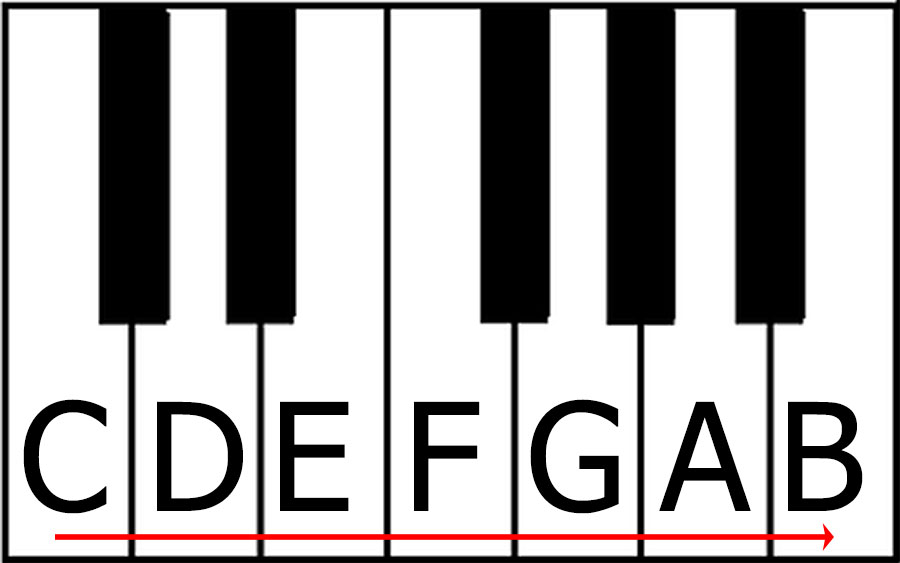
Pianoforte keyboard layout: there is only 1 path, 1 option for playing the C major calibration from C lowest to C one octave (7 white frets) higher
For case, suppose yous want to play a C major calibration that starts from the third frets of the fifth string (A cord). We all know (at to the lowest degree we should) that the C major scale is composed of C, D, E, F, Grand, A, B notes.
Accept a look at the image below: clearly you have different paths. You could skip string soon after the C and play the D note on the quaternary string (D), or you could stay on the fifth string, playing the D on the fifth cord.

Guitar fretboard layout: there exist different paths for playing the same scale
(option 1: yellow path , option two: red path )
From a beginner perspective, having too many options makes things complicated . On the other mitt, for those who master the fretboard, the nature of the guitar layout enhances the expressive and musical possibilities.
But don't worry, you'll encounter some strategies useful to tame the fretboard complexity.
Play tricks due north.1: Run into the fretboard strings every bit 6 pianoforte keyboards
One proficient mental fob useful to empathize the fretboard, is to consider every string like a singled-out piano keyboard , that starts from the respective notation.
Every bit said earlier, the standard tuning of the guitar, starting from the thickest string to the thinner, is Eastward A D G B E .
- The sixth cord (and its related piano keyboard) starts with the Due east note
- The fifth string (and its related piano keyboard) starts with the A note
- The fourth cord (and its related piano keyboard) starts with the D note
- The third cord (and its related piano keyboard) starts with the G note
- The second string (and its related piano keyboard) starts with the B notation
- The showtime cord (and its related pianoforte keyboard) starts with the Due east note (ii octaves, 14 white keys higher than the lowest E string)

Fretboard strings relationship and guitar standard tuning
Given the piano keyboard - strings analogy, information technology's easier to explain the standard guitar tuning . First of all, we need to have at least the E lowest cord tuned with the assistance of a tuner device.
This give u.s. a standard reference coherent with other musicians. Then we can tune the other strings using the previous cord equally a reference.
We said that the fifth cord has to exist an A note.
- So we press the A note on the sixth string (low E), that is located at the 5th fret, and nosotros tune the 5th open string (A) until the 2 strings sounds with the same pitch.
- We do the same with the other strings (see the diagram below).
- The fourth open string (D) has to have the same pitch of the 5th fret of the fifth cord.
- The third open string (G) has to have the same pitch of the 5th fret of the fourth cord, then along.
- Just notice the pocket-size difference at the third string (G), on which y'all must play the 4th fret (instead of the 5th) to tune the second string (B). We'll come across why later.
This video shows you clearly how to tune your guitar

Guitar standard tuning
What nearly the black keys? (half-steps and whole steps)
Non information technology's time to talk about a bit (just a bit) music theory. In western music, the minimum distance between two notes is chosen one-half-footstep (or semitone).
A distance of ii one-half-steps is called whole stride . On the piano keyboard, the distance between the keys (white or black) is i half-pace .
If we look again at the piano keyboard, nosotros can see that at that place is a black key between each pair of white keys, except for the infinite between the B and C keys , and the E and F keys .
So here's the kickoff of import affair to observe:
- Betwixt C and D in that location is 1 whole-step (2 half-steps)
- Between D and E in that location is one whole-step (2 one-half-steps)
- Between E and F at that place is 1 half-steps
- Between F and G there is one whole-step (2 half-steps)
- Between G and A there is ane whole-step (2 half-steps)
- Between A and B there is ane whole-step (ii one-half-steps)
- Betwixt B and C at that place is i half-steps
Thus,the structure of the Major Scale is composed of two whole steps ( C-D-East ), 1 half-step ( East-F ), 3 whole steps ( F-M-A-B ) and ane one-half-step ( B-C ). On the fingerboard, nosotros have non black or white keys, but we take frets .
i fret = one half-footstep = 1 semitone
Let's look at the C Major Scale on the guitar neck . As previously said before, we have unlike options for playing a given scale.
This fourth dimension, for visualization convenience, I've called to start from the first fret of the B string , that is a C, and play the scale horizontally on the same string , in order to visualize better the steps and half-steps structure:

C major calibration on the second (B) string
Sharps and flats and neck frets
In music theory, there are 2 symbols that, when applied to a annotation, change its pitch and its name. They are chosen sharps and flats:
apartment (b) : lowers a note by 1 one-half-footstep
sharp (#) : raises a annotation by i half-stride
For example, a D flat is a D note lowered by 1 half-step, while a C sharp is a C note raised by 1 half-step. D flat and C abrupt have dissimilar names, but they have the same pitch .
On the guitar fretboard, they are placed on the aforementioned fret ! You'll learn why the same fret tin can take different names in future lessons, technically this topic is called " enharmonics ", just don't worry for now.
Permit's at present introduce the chromatic scale , a scale composed of 12 half-steps required for going from a annotation to the aforementioned note 1 octave above.
The C chromatic scale is the post-obit:
C - C#/Db - D - D#/Eb - E - F - F#/Gb - G - G#/Ab - A - A#/Bb - B - C

C chromatic scale on the second (B) string
Playing the chromatic scale on the fretboard is straightforward because yous only take to play ane fret after the other. Notice that between the lowest C and the higher C there are 12 frets , or 12 one-half-steps
Pull a fast one on n.2: Fretboard Octaves
Beginners guitars players normally memorize but the notes on the sixth and fifth strings , because they have learned bar chords shapes and they need to notice the root note of the chords.
Starting from this noesis, it's possible to exploit the fretboard geometry to find notes on the other strings.
In the following diagrams I'll show you the so chosen octave intervals : starting from a given notes, you can find the same note on the higher strings, one or 2 octaves above.
This is a corking visual assist that helps you discover your notes apace.
Octaves will be as well useful when you'll arroyo guitar triads and chord inversions.

6th string octaves, option 1: 2 strings upwards (toward the thinnest), ii frets higher

6th string octaves, option ii: three strings upwardly (toward the thinnest), three frets lower

6th string octaves, option 3: the 1st cord (the thinnest) has the same notes of the 6th (the thickest), 2 octaves up

5th cord octaves, pick 1: two strings upward (toward the thinnest), 2 frets college

fifth cord octaves, pick 2: iii strings up (toward the thinnest), two frets lower

4th string octaves, selection ane: ii strings upward (toward the thinnest), 3 frets higher

4th string octaves, pick two: three strings upwardly (toward the thinnest), 2 frets lower

3rd string octaves, option ane: two strings upwardly (toward the thinnest), 3 frets higher
Here is a comprehensive diagram with the octaves linked together. Practice and memorize these geometric relationships, as they are an invaluable tool for navigating the fretboard effortlessly

C note octaves
In the costless guitar notes chart pdf , you'll find several neck notes map. Let's accept a await at them:
We can have natural notes (C D Eastward F M A B), notes with sharps (like C# and D#) and notes with flats (like Bb, Db and Eb).
In the kickoff, information technology'due south easier to memorize just the natural notes, and then the notes with flats, and finally the notes with sharps.

Diagram showing only natural notes (no sharps and no flats) Click to zoom 
Diagram showing natural notes and sharps notes. Click to zoom 
Diagram showing natural notes and flats notes. Click to zoom
The chart pdf contains several fretboard maps , each 1 showing a particular guitar key . In this way is easier to focus on the notes of a given key and learn the notes step-by-pace. The layout of the maps is clear and easy-to-call up
In the diagrams, the musical keys are organized post-obit the circle of fifths , that is a way to display and memorize the sharps/flats that belong to a given fundamental.
Starting from the C primal, that has not whatsoever abrupt/flat, you'll discover that changing cardinal, following the circle of the fifths, will introduce just i single sharp/flat at a time.
Don't worry if you're not familiar with the circumvolve of fifths , this concept is well visualized in the pdf.
Here below y'all find some guitar notes map for the nearly mutual tonalities.
Neck Notes Chart for C Major Key
- C Major : C - D - East - F - G - A - B - C
Sharps/flats: none
As said before, one of the best means to larn the notes on the fretboard is to start memorizing only the natural notes. This strategy requires less effort, as you have to bargain with merely 7 notes.
So here below you discover the guitar notes diagram for the C key , that has natural notes only.
Take your time to memorize these notes, as they'll be the foundation for more complex concepts.

Fretboard Diagram for One thousand Major Key
Once you lot have the major C notes under your belt, you tin proceed to the next central, that, post-obit the circle of fifths, is the G key.
The G key has the F precipitous instead of the F , then you merely have to enhance the F by one half-step
- G Major : Thousand - A - B - C - D - East - F# - G
Sharps/flats: F#

Guitar Fretboard Notes Chart for D Major Fundamental
- D Major : D - East - F# - 1000 - A - B - C# - D
Sharps/flats: F# C#
The D major key introduces the C precipitous notes, now you lot're a fretboard wizard and you easily find this new note by raising the C note by ane one-half-step.

Guitar Notes Diagram for A Major Central
- A Major : A - B - C# - D - E - F# - Yard# - A
Sharps/flats: F# C# Thou#
The same machinery of above, the new notation in A major key is G#. And then delight enhance that Thousand by i half-step

Guitar Neck Diagram for Due east Major Key
- Due east Major : East - F# - M# - A - B - C# - D# - E
Sharps/flats: F# C# Yard# D#
Here it comes E major key with a new notation, the D abrupt

Fretboard Notes Chart for B Major Fundamental
- B Major : B – C# - D# - Eastward - F# - G# - A# - B
Sharps/flats: F# C# G# D# A#
At present it's time of the B major key, A sharp is the new note! Yous'll find the other keys and relative diagrams in the pdf .

Tricks four: Online Fretboard Trainer Game
We are a little proud of this tool because is used by thousands of guitar players on a daily basis. It's a free browser game that you can use online, without installing anything.
It helps you memorize all the fretboard notes quickly while having fun. Launch the fretboard trainer now.
There are many exercises to memorize the fretboard , but this little tool can really speed up your learning, bank check it out!
Guitar Neck Notes | Conclusions
Ok, in this tutorial we have covered a lot of footing. Now you should have a good noesis of the guitar fretboard and some material to work on.
Take your fourth dimension to internalize these concepts, download the notes map pdf , practise the fretboard trainer game at least ten minutes a day, and in no time you'll find yourself flying effortlessly up and down the neck .
If you have any doubts or question, just ask in the comments below, and please share your feedback.
To stay updated on new tutorials, subscribe to the complimentary newsletter (you'll also get access to the download area with lots of free printable resources)
Source: https://www.fachords.com/guitar-fretboard-notes/
0 Response to "How to Read Guitar Notes on Guitar Neck"
ارسال یک نظر